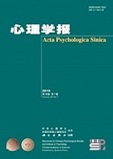|
|
Observer’s Hand Orientation Influences Mental Rotation of A Hand Stimulus
TAO Wei-Dong,HUANG Xi-Ting,ZHANG Hui,FENG Si-Hai,LIU Qiang,TAO Xiao-Li,XIE Chao-Xiang,LI Hong,SUN Hong-Jin
2009, 41 (01):
10-25.
Mental rotation refers to the cognitive process in which a person imagines how an object or array would appear if rotated away from the PRENSETED OR USUAL orientation (Thayer & Johnson, 2006). Humans utilize this visuospatial ability to solve a range of spatial reasoning problems in daily life, such as recognition, navigation, and action planning, etc. (Creem, 2007).It was proposed that when participants are required to make a left-right judgment of a display of hands or bodies rotated from upright orientation, they could invoke ego-centric mental transformation, rather than object-centric mental rotation (Parsons, 2003; Zacks, 2005)
Tao et al (2007, 2008) described the in-rotation effect in mental rotation of the hand. In their experiments, participants completed a left or right hand judgment task when either a left or right hand picture was presented. The results showed that in-rotation (rotated medially) hand was recognized more quickly and accurately than out-rotation hand. This suggests that the processing of mental rotation is limited by the biomechanical constraints of the corresponding physical rotation. However, it remains possible that this in-rotation effect is not necessarily the definitive proof for observers’ mental rotation of their own hands, because this in-rotation effect can either be the result of a mental imagery of the movements of one’s own hand or simply the participants’ knowledge of biomechanical constrain.
In the current study, seated participants place their own hands on their laps, the orientation of their hands were manipulated with either palm or back of the hands facing up (Experiment 1) or with their palm facing up but one of hands rotated 90 degrees (Experiment 2). Using the same left or right hand judgment task as in Tao et al (2008), we recorded participants’ performance (reaction time and response errors) together with eye movement data during the task. First, we determined whether the mental transformation was based on participant’s own hands or hands in the visual display. If the imagery was participants’ own hands, then participant’s own hand position would influence mental rotation of the hand stimulus. Second, we determined whether rotation direction would affect eye-movement measures, such as average fixation duration and total number of fixation et al. Third, we determined whether the gaze distributed equally on the hand picture in the encoding and validating stages of the mental rotation.
The results of the two experimental showed that (1) When the palm or back view of the stimulus hand was consistent with that of the participants’ hand (whether palm or back was facing the eye, either for both hands or for only the corresponding hand), participants’ judgment was faster and more accurate than the case where the facing direction of the participants’ hands and stimulus hands were not consistent;
when participants’ hand orientation was consistent with the that of the displayed hand picture, participants’ judgment was faster and more accurate than the case where the orientation of the participants’ hands and stimulus hands were not consistent; 2) for the same magnitude of rotation, in-rotation (rotated medially) hands was recognized more quickly and accurately than out-rotation hands especially in palm pictures. (3) This in-rotation effect was also found in total gaze duration, average fixation duration and proportion of gazes in thumb area over the entire hand picture; (4) in encoding and validating stages of the mental rotation process, the gaze was distributed in an asymmetrical fashion in both palm or back hand pictures, with the gaze concentrating on the thumb area; (5) all the right hand picture was recognized more quickly and accurately than left hand stimulus.
These results suggest that participants’ own hand influenced mental rotation of the hand, and the results strongly suggest that the in-rotation effect was indeed the result of the motor imagery of the participants’ actual hand (rather than the hands in the display) and thus demonstrating the biomechanical constrain. The finding that thumb area was the dominant gaze area provides insight for the nature and sequence of stages of mental rotation process
Related Articles |
Metrics
|




